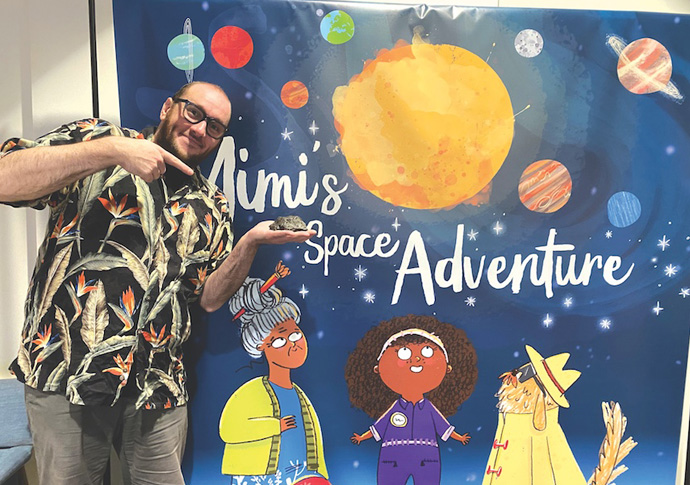Making space for everyone…
Diversity at the heart of a family-friendly approach to physics. Daisy Clague reports
Friday, 30th August 2024 — By Daisy Clague

A FRAGMENT of a 4.5 billion-year-old solid metal meteorite, leftover from the creation of the Solar System, that fell to Earth 5,000 years ago has made its way to Islington.
“It’s the oldest thing you will ever touch,” said Toby Shannon-Smith, public engagement manager at the Institute of Physics (IOP). “As old as the Sun, the planets, older than anything on the surface of the Earth.”
As the professional body for physics in the UK and Ireland, the IOP aims to make physics accessible to people from all backgrounds, which is why the lecture hall in its Caledonian Road headquarters was transformed into a space adventure exhibition for children over the summer.
“Families can come in and start to get an idea that physics is for them and that this building they probably walk past all the time is part of their community. We wanted people to come in and play and make themselves at home.”
The institute hosted workshops with local primary schools in the summer term, including Vittoria, St John’s Upper Holloway and Sacred Heart, and the exhibition was open to the public throughout July and August.
As well as the weighty meteorite fragment and other rocks from Mars and the Moon – on loan from Nasa and brought to the IOP with funding from the UK Space Agency – the exhibition included activities for kids and stories about the huge range of jobs relating to physics and space.
“People might think that you do physics and either become a physicist or a science teacher,” said Mr Shannon-Smith. “But you can apply the skills you’ve gained in physics to stable, well-paid jobs in all sorts of important fields.”
Some of the jobs highlighted in the exhibition are based on real life, such as a physiotherapist for astronauts returning to Earth, and a researcher investigating how to make space travel accessible to people with disabilities. Others are fictional physics role models, like Tai, a non-binary space junk tracker who has ADHD.
The exhibition was centred on the characters from a book written by Mr Shannon-Smith. Mimi’s Space Adventure tells the story of a young black girl who goes on adventures with her artist-inventor granny and her granny’s dog, Colin, during the summer holidays.
“We’ve observed that our visitor demographic has become more and more diverse since having Mimi as a central character,” said Mr Shannon-Smith, adding that the exhibition was designed to encourage diversity and inclusion in the broadest sense, for young people regardless of gender, ethnicity, ability, sexuality and socio-economic background. As if to prove this point, one little girl visiting the exhibition at the same time as the Tribune pointed at Mimi’s picture and said to her mum: “She looks just like me!”
Mr Shannon-Smith’s work in science communication is about dismantling the barriers to young people being able to see themselves in physics. “Physics has the best stories,” he said. “When I was doing my physics degree I realised I didn’t have the kind of brain that would let me focus on one individual detail until I became an expert in that one tiny thing.
“I wanted to be able to use all the colours in the paint box and play in a much bigger space. So when I found out that science communication was a job, I knew that was what I wanted to do.
“Now I can have great conversations with a 13-year-old aspiring scientist about things like black holes and neutron stars, or talk with younger kids about the really fundamental stuff.
“Having those conversations is one of the things that gets me out of bed in the morning.”
• Any school or individual that would like a free copy of Mimi’s Space Adventure visit www.iop.org/explore-physics/mimis-space-adventure